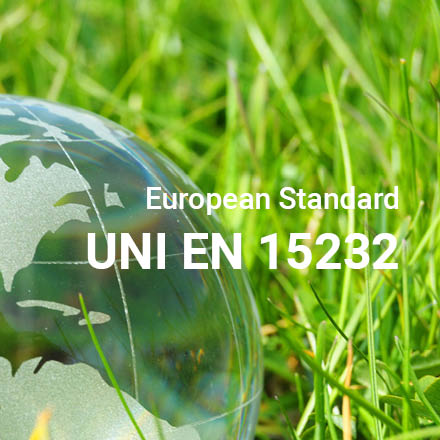The European standard EN15232-1 refers to the “Energy performance of buildings – Impact of automation and of technical management on the eneregy consumption of buildings” and describes the method to estimate the efficiency of automation systems for all facilities that supply heating, for the production of domestic hot water, air conditioning, the ventilation and lighting in a building.
The standard evaluates the effects of BACS (Building Automation and Control Systems) and TBM (Technical Building Management) technologies on consumptions and presents a method for calculating their impact on the energy performance of the building. This method in turn uses specific reference standards for each type of system.
The standard introduces a method to “estimate” energy efficiency to be attributed to the control and automation system of energy loads, in particular to all systems that supply:
• Heating
• Domestic hot water production
• Air conditioning
• Ventilation
• Lighting
These services, present inside all buildings, are responsible for about 40% of European Union primary energy need. The first edition of EN 15232 Standard dates back to 2007, replaced in 2012 by the second edition up to the current version, the third one published in May 2017.
EN 15232 Standard introduces following definitions:
BAC – Building Automation and Control
Building automation and control: this definition includes the set of products, systems, services, monitoring and optimization activities aimed to achieve a building energy efficiency level.
BACS – Building Automation and Control System
Building automation and control system: includes the above mentioned items, designed, built and managed for the improvement of the energy efficiency of a building.
TBM – Technical Building Management
Set of processes and services intended for the operation management, maintenance and control of technical systems for the verification of their efficiency also through relations between the various technologies.
BACS Efficiency Class
Efficiency class of a BACS system. The Standard defines four classes, from D to A with an increasing degree of energy performance.

The various energy efficiency classes are briefly commented below.
Class A – BACS and TBM with high performances
BAC with high performances of energy efficiency and technical building management activity (TBM).
Class B – advanced BACS and TBM
Advanced BAC with some specific building management activities (TBM).
Class C – standard BACS
Standard BAC, normal control and setting systems equipped also with communication bus but not chatacterized by particular functional performances from the point of view of energy efficiency.
Classe D – non efficient BACS
BAC not energy efficient. Buildings with class D systems must necessarily be revamped and made more efficient. New buildings must not be built with class D systems. A building is classified D if the new minimum functionalities required for class C are not implemented. It is therefore clear that all new buildings, that have been built in Italy since 2007, equipped with traditional systems, have been designed and built without compliance with this standard.
The standard therefore defines a list of “control functions” for each technology. As regards lighting, the presence control and control solutions based on natural light are considered. Below is a summary of Table 5 of the UNI EN 15232-1 “Lighting control functions” for non-residential buildings.

In Italy recent evolutions in law and standards (Interministerial Decree 26/06/2015 – Attachment 1 -Art.3.2) have introduced the mandatory adoption of control systems and automatic setup of lighting systems (in non-residential premises), in order to achieve energy efficiency levels compliant with EU regulations.
For buildings of non-residential use, a minimum level of automation corresponding to Class B of the UNI EN 15232 Standard is therefore also mandatory for lighting.
It is possible to learn more about the issues relating to the UNI EN 15232 Standard downloading the document “Energy Efficiency: impact of automation on the energy performance of buildings – Schneider Electric Guide to the use of UNI EN15232: 2012” available at the link www.se.com/it/it/download/document/LEESGTF007FI.
